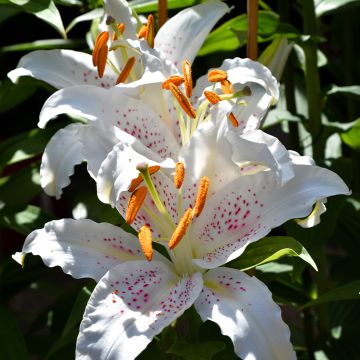

Lilium Bataleon - Lily
Lilium Bataleon - Lily
Lilium Bataleon
Lily
Special offer!
Receive a €20 voucher for any order over €90 (excluding delivery costs, credit notes, and plastic-free options)!
1- Add your favorite plants to your cart.
2- Once you have reached €90, confirm your order (you can even choose the delivery date!).
3- As soon as your order is shipped, you will receive an email containing your voucher code, valid for 3 months (90 days).
Your voucher is unique and can only be used once, for any order with a minimum value of €20, excluding delivery costs.
Can be combined with other current offers, non-divisible and non-refundable.
Why not try an alternative variety in stock?
View all →This plant carries a 6 months recovery warranty
More information
We guarantee the quality of our plants for a full growing cycle, and will replace at our expense any plant that fails to recover under normal climatic and planting conditions.
Would this plant suit my garden?
Set up your Plantfit profile →
Description
The Lily 'Bataleon' is a hybrid of Trumpet Lily and Asiatic Lily that offers magnificent flowers of a deep and velvety red. This cultivar produces several flowers per bulb, up to 5-6 flowers for a large bulb, in the heart of summer. Besides its intense colour, it is appreciated for its quite remarkable ornamental value and ease of cultivation. 'Bataleon' is suitable for sunny flowerbeds as well as floral compositions.
An offspring of the cross-breeding between a Trumpet Lily and an Asiatic Lily, the Lilium 'Bataleon' was developed by the breeder Mak Breeding BV, a Dutch company specialised in lily hybridization. This cultivar reaches a height of about 1.15 m and produces upward-facing flowers. Its flowering usually starts at the end of July and continues until August. Its flowers, deep red and velvety, may sometimes display darker shades towards the centre. The elongated floral buds open into large flowers of 12 to 15 cm in diameter, with no scent. The sturdy, erect stems bear dark green foliage, composed of elongated and narrow leaves arranged alternately. This variety produces several flowers per bulb depending on its size, up to 6 flowers for a large bulb. The vegetation is deciduous: it emerges from the ground in spring and disappears in autumn.
Lilies are classified into horticultural divisions based on their flowering characteristics, geographical origin, and growth habits. TA hybrids (Trumpet x Asiatic) are interdivisional hybrids that blend two groups of lilies from different divisions in horticultural classification. However, they are commonly classified in Division VIII of lilies, which includes hybrids referred to as "uncategorisable" or "interdivisional". Therefore, they are often officially named "Trumpet x Asiatic Interdivisional Hybrids" or simply "TA Hybrids". In horticultural databases, they may also appear under the general term Division VIII - Other Hybrids.
This designation remains informal and is primarily used in horticulture, as traditional botanical classification focuses more on natural species and less on complex interdivisional hybrids.
Plant this Lily 'Bataleon' in flowerbeds as well as in pots on a terrace, balcony, or even in a cold greenhouse. You can also cut the flowers to create luxuriant bouquets. It is perfect for adding height and colour to flowerbeds or at the base of a hedge. It pairs well with other lily varieties like 'Navona' for an elegant white-red contrast, or with the Lily 'African Queen' with its orange hues. It also pairs well with the perennial geranium 'Rozanne', which softens its presence with its blue flowers. Variegated hostas are interesting for playing with textures and highlighting its flowering stems in flowerbeds.
Plant habit
Flowering
Foliage
Botanical data
Lilium
Bataleon
Liliaceae
Lily
Cultivar or hybrid
Other Hybrid Lilies
View all →Planting and care
The Lily 'Bataleon' enjoys being placed in full sun with the base in the shade. Plant it 10 cm deep in a fertile, well-drained soil enriched with compost. Keep the soil moist, but not excessively wet. Lily bulbs appreciate the winter cold which allows them to root. Beware of spring frosts that can damage young shoots. Water regularly during growth, but make sure not to let the soil become waterlogged to prevent bulb rot. Once the flowers have faded, remove the flower stems while keeping the foliage until it naturally withers, as this helps the bulbs store energy for the next flowering. Finally, a protective mulch in winter can be useful in colder climates to ensure vigorous regrowth in spring.
Our Tip: Lilies adapt well to container gardening. Plant 1 to 5 bulbs in a deep container. Water lightly and place your pots in a frost-free area. Bring them out to your patios in spring to enjoy them to the fullest.
Planting period
Intended location
Care
Planting & care advice
This item has not been reviewed yet - be the first to leave a review about it.
Haven't found what you were looking for?
Hardiness is the lowest winter temperature a plant can endure without suffering serious damage or even dying. However, hardiness is affected by location (a sheltered area, such as a patio), protection (winter cover) and soil type (hardiness is improved by well-drained soil).

Photo Sharing Terms & Conditions
In order to encourage gardeners to interact and share their experiences, Promesse de fleurs offers various media enabling content to be uploaded onto its Site - in particular via the ‘Photo sharing’ module.
The User agrees to refrain from:
- Posting any content that is illegal, prejudicial, insulting, racist, inciteful to hatred, revisionist, contrary to public decency, that infringes on privacy or on the privacy rights of third parties, in particular the publicity rights of persons and goods, intellectual property rights, or the right to privacy.
- Submitting content on behalf of a third party;
- Impersonate the identity of a third party and/or publish any personal information about a third party;
In general, the User undertakes to refrain from any unethical behaviour.
All Content (in particular text, comments, files, images, photos, videos, creative works, etc.), which may be subject to property or intellectual property rights, image or other private rights, shall remain the property of the User, subject to the limited rights granted by the terms of the licence granted by Promesse de fleurs as stated below. Users are at liberty to publish or not to publish such Content on the Site, notably via the ‘Photo Sharing’ facility, and accept that this Content shall be made public and freely accessible, notably on the Internet.
Users further acknowledge, undertake to have ,and guarantee that they hold all necessary rights and permissions to publish such material on the Site, in particular with regard to the legislation in force pertaining to any privacy, property, intellectual property, image, or contractual rights, or rights of any other nature. By publishing such Content on the Site, Users acknowledge accepting full liability as publishers of the Content within the meaning of the law, and grant Promesse de fleurs, free of charge, an inclusive, worldwide licence for the said Content for the entire duration of its publication, including all reproduction, representation, up/downloading, displaying, performing, transmission, and storage rights.
Users also grant permission for their name to be linked to the Content and accept that this link may not always be made available.
By engaging in posting material, Users consent to their Content becoming automatically accessible on the Internet, in particular on other sites and/or blogs and/or web pages of the Promesse de fleurs site, including in particular social pages and the Promesse de fleurs catalogue.
Users may secure the removal of entrusted content free of charge by issuing a simple request via our contact form.
The flowering period indicated on our website applies to countries and regions located in USDA zone 8 (France, the United Kingdom, Ireland, the Netherlands, etc.)
It will vary according to where you live:
- In zones 9 to 10 (Italy, Spain, Greece, etc.), flowering will occur about 2 to 4 weeks earlier.
- In zones 6 to 7 (Germany, Poland, Slovenia, and lower mountainous regions), flowering will be delayed by 2 to 3 weeks.
- In zone 5 (Central Europe, Scandinavia), blooming will be delayed by 3 to 5 weeks.
In temperate climates, pruning of spring-flowering shrubs (forsythia, spireas, etc.) should be done just after flowering.
Pruning of summer-flowering shrubs (Indian Lilac, Perovskia, etc.) can be done in winter or spring.
In cold regions as well as with frost-sensitive plants, avoid pruning too early when severe frosts may still occur.
The planting period indicated on our website applies to countries and regions located in USDA zone 8 (France, United Kingdom, Ireland, Netherlands).
It will vary according to where you live:
- In Mediterranean zones (Marseille, Madrid, Milan, etc.), autumn and winter are the best planting periods.
- In continental zones (Strasbourg, Munich, Vienna, etc.), delay planting by 2 to 3 weeks in spring and bring it forward by 2 to 4 weeks in autumn.
- In mountainous regions (the Alps, Pyrenees, Carpathians, etc.), it is best to plant in late spring (May-June) or late summer (August-September).
The harvesting period indicated on our website applies to countries and regions in USDA zone 8 (France, England, Ireland, the Netherlands).
In colder areas (Scandinavia, Poland, Austria...) fruit and vegetable harvests are likely to be delayed by 3-4 weeks.
In warmer areas (Italy, Spain, Greece, etc.), harvesting will probably take place earlier, depending on weather conditions.
The sowing periods indicated on our website apply to countries and regions within USDA Zone 8 (France, UK, Ireland, Netherlands).
In colder areas (Scandinavia, Poland, Austria...), delay any outdoor sowing by 3-4 weeks, or sow under glass.
In warmer climes (Italy, Spain, Greece, etc.), bring outdoor sowing forward by a few weeks.





















































